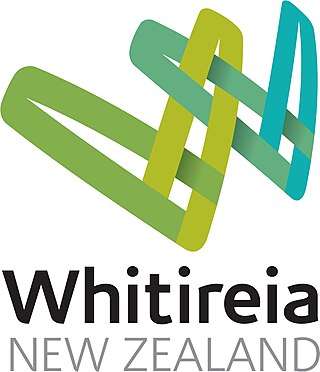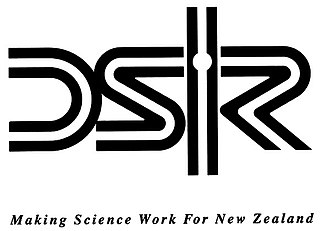
Victoria University of Wellington is a public research university in Wellington, New Zealand. It was established in 1897 by Act of Parliament, and was a constituent college of the University of New Zealand.
In New Zealand, Crown Research Institutes (CRIs) are corporatised Crown entities charged with conducting scientific research.
The MacDiarmid Institute for Advanced Materials and Nanotechnology is a New Zealand Centre of Research Excellence (CoRE) specialising in materials science and nanotechnology. It is hosted by Victoria University of Wellington, and is a collaboration between five universities and two Crown Research Institutes.
Industrial Research Limited (IRL) was a Crown Research Institute of New Zealand that was established in 1992 and merged into Callaghan Innovation, a new Crown entity, on 1 February 2013. IRL provided research, development and commercialisation services aimed at fostering industry development, economic growth and business expansion. It was established when the Department of Scientific and Industrial Research was disbanded and its staff and assets redistributed to form the research institutes in 1992.

Sir Paul Terence Callaghan was a New Zealand physicist who, as the founding director of the MacDiarmid Institute for Advanced Materials and Nanotechnology at Victoria University of Wellington, held the position of Alan MacDiarmid Professor of Physical Sciences and was President of the International Society of Magnetic Resonance.
Klaus Bechgaard was a Danish scientist and chemist, noted for being one of the first scientists in the world to synthesize a number of organic charge transfer complexes and demonstrate their superconductivity, therefore the name Bechgaard salt. These salts all exhibit superconductivity at low temperatures.

Whitireia New Zealand, previously called Whitireia Community Polytechnic and Parumoana Community College, is a government-owned and funded tertiary education institute in New Zealand. It was established in 1986 on the shores of Porirua Harbour and today has 7,500 students, with campuses in Auckland, Wellington, Petone and Porirua.
Te Ara Ahunga Ora Retirement Commission, is a Crown entity under the New Zealand Crown Entities Act 2004. The Commission provides financial education and information to residents of New Zealand, advises government on retirement income policy, and monitors the effectiveness of the Retirement Villages Act 2003.

The Department of Scientific and Industrial Research (DSIR) was a government science agency in New Zealand, founded in 1926 and broken into Crown Research Institutes in 1992.

The Malaghan Institute of Medical Research is an independent biomedical research institute based in Wellington, New Zealand. The Malaghan Institute specialises in the immune system, and how it can be harnessed to improve human health. Its key areas of research and discovery are cancer, asthma and allergy, infectious disease, gut health and brain health. In 2019, the Institute began New Zealand's first clinical trial of CAR T-cell therapy, trialling a third-generation CAR T-cell therapy in partnership with Wellington Zhaotai Therapies.

Amit Goyal is a SUNY Distinguished Professor and a SUNY Empire Innovation Professor at SUNY-Buffalo. He leads the Laboratory for Heteroepitaxial Growth of Functional Materials & Devices. He is also Director of the New York State Center of Excellence in Plastics Recycling Research & Innovation, an externally funded center with initial funding of $4.5M for three years at SUNY-Buffalo. He is the founding director of the multidisciplinary and transdisciplinary RENEW Institute at SUNY-Buffalo in Buffalo, New York and served as director from 2015-2021. RENEW is an internally funded research institute at SUNY-Buffalo. For his contributions to UB, in 2019, he was awarded the University at Buffalo or SUNY-Buffalo President's Medal, which recognizes “outstanding scholarly or artistic achievements, humanitarian acts, contributions of time or treasure, exemplary leadership or any other major contribution to the development of the University at Buffalo and the quality of life in the UB community.” This is one of the highest recognitions given at the university.

The Canterbury Earthquake Recovery Authority was the public service department of New Zealand charged with coordinating the rebuild of Christchurch and the surrounding areas following the 22 February 2011 earthquake. After it was disestablished on 18 April 2016, CERA's functions were taken over by a variety of other agencies.

Robert John Ferrier FRSNZ, FNZIC, was an organic chemist who discovered two chemical reactions, the Ferrier rearrangement and the Ferrier carbocyclization. Originally from Edinburgh, he moved to Wellington, New Zealand, in 1970.

Roderick Leon Bieleski was a New Zealand plant physiologist. As a botanist and horticulturist, his research focussed on understanding the factors that affected the behaviour of plants, in particular horticultural crops. His work had practical relevance to farmers and orchardists in building their understanding of these factors and taking account of them while making a living from growing and harvesting plants. He received many honours and awards, culminating in being appointed Member of the New Zealand Order of Merit (MNZM) in 2010.
Jeffery Lewis Tallon is a New Zealand physicist specialising in high-temperature superconductors.
The Biotechnology Innovation Organization (BIO) is the largest advocacy association in the world representing the biotechnology industry. It was founded in 1993 as the Biotechnology Industry Organization from a merger of the Industrial Biotechnology Association (IBA) and the Association of Biotechnology Companies (ABC), and changed its name to the Biotechnology Innovation Organization on January 4, 2016. Biotechnology Innovation Organization serves more than 1,100 biotechnology firms, research schools, state biotechnology centers and related associations in the United States and in more than 30 other countries.

The Real Estate Authority (REA), formerly the Real Estate Agents Authority (REAA), is the New Zealand Crown entity responsible for the regulation of the New Zealand real estate industry as well as the agents within it.

Margaret Mary Hyland is a Canadian-born chemist based in New Zealand whose research focuses on aluminium technology, and the chemistry and engineering of material surfaces. She moved to New Zealand in 1989 and after holding many senior academic leadership roles supporting and developing research at the faculty, university and national level became recognised as an authority on the generation and capture of fluoride emissions from aluminium smelters and for coordinating the team that produced the 'Fluoride Emissions Management Guide' for the aluminium industry. This achievement was acknowledged when she became the first woman to win the Pickering Medal. In 2017, Hyland was seconded to the Ministry of Business, Innovation and Employment in the role of Chief Scientist and has held positions in a variety of other groups supporting the physical sciences and engineering. Since 2018 she has been Vice-Provost, (Research) at Victoria University of Wellington, New Zealand.

Shaun Cameron Hendy is a New Zealand physicist. He is the chief scientist at climate innovation company Toha. He was previously a professor at the University of Auckland and was the first director of Te Pūnaha Matatini, a centre of research excellence in complex systems and data analytics. During the COVID-19 pandemic in New Zealand, he led a team of scientists developing mathematical models of the spread of the virus across the country that influenced the government's response to the outbreak.












